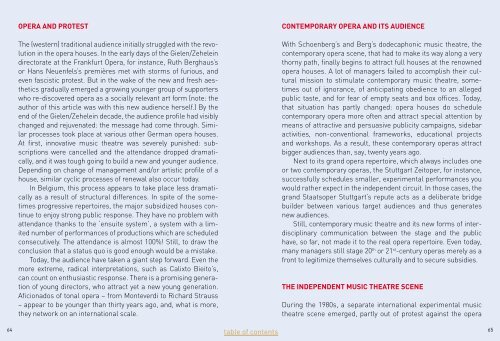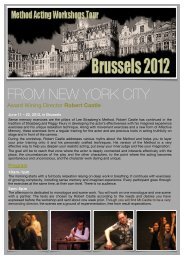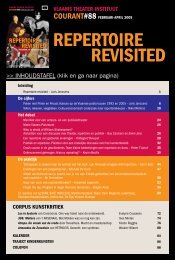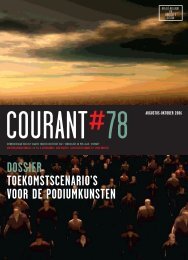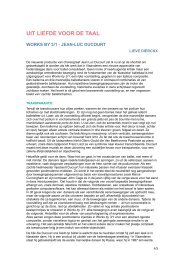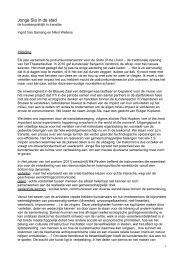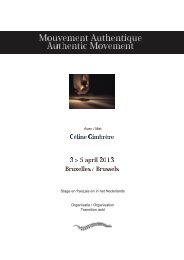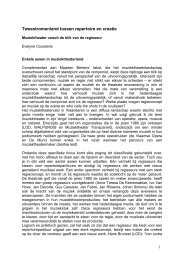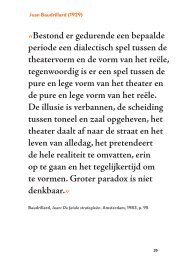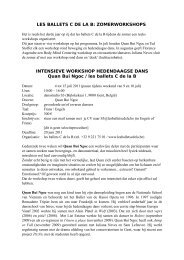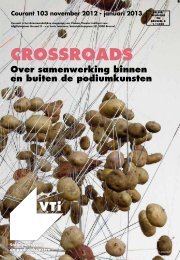music theatre in flanders - Muziekcentrum Vlaanderen
music theatre in flanders - Muziekcentrum Vlaanderen
music theatre in flanders - Muziekcentrum Vlaanderen
Create successful ePaper yourself
Turn your PDF publications into a flip-book with our unique Google optimized e-Paper software.
OperA And prOTeST<br />
The (western) traditional audience <strong>in</strong>itially struggled with the revolution<br />
<strong>in</strong> the opera houses. In the early days of the Gielen/Zehele<strong>in</strong><br />
directorate at the Frankfurt Opera, for <strong>in</strong>stance, Ruth Berghaus’s<br />
or Hans Neuenfels’s premières met with storms of furious, and<br />
even fascistic protest. But <strong>in</strong> the wake of the new and fresh aesthetics<br />
gradually emerged a grow<strong>in</strong>g younger group of supporters<br />
who re-discovered opera as a socially relevant art form (note: the<br />
author of this article was with this new audience herself.) By the<br />
end of the Gielen/Zehele<strong>in</strong> decade, the audience profile had visibly<br />
changed and rejuvenated: the message had come through. Similar<br />
processes took place at various other German opera houses.<br />
At first, <strong>in</strong>novative <strong>music</strong> <strong>theatre</strong> was severely punished: subscriptions<br />
were cancelled and the attendance dropped dramatically,<br />
and it was tough go<strong>in</strong>g to build a new and younger audience.<br />
Depend<strong>in</strong>g on change of management and/or artistic profile of a<br />
house, similar cyclic processes of renewal also occur today.<br />
In Belgium, this process appears to take place less dramatically<br />
as a result of structural differences. In spite of the sometimes<br />
progressive repertoires, the major subsidized houses cont<strong>in</strong>ue<br />
to enjoy strong public response. They have no problem with<br />
attendance thanks to the ‘ensuite system’, a system with a limited<br />
number of performances of productions which are scheduled<br />
consecutively. The attendance is almost 100%! Still, to draw the<br />
conclusion that a status quo is good enough would be a mistake.<br />
Today, the audience have taken a giant step forward. Even the<br />
more extreme, radical <strong>in</strong>terpretations, such as Calixto Bieito’s,<br />
can count on enthusiastic response. There is a promis<strong>in</strong>g generation<br />
of young directors, who attract yet a new young generation.<br />
Aficionados of tonal opera – from Monteverdi to Richard Strauss<br />
– appear to be younger than thirty years ago, and, what is more,<br />
they network on an <strong>in</strong>ternational scale.<br />
COnTeMpOrAry OperA And ITS AudIenCe<br />
With Schoenberg’s and Berg’s dodecaphonic <strong>music</strong> <strong>theatre</strong>, the<br />
contemporary opera scene, that had to make its way along a very<br />
thorny path, f<strong>in</strong>ally beg<strong>in</strong>s to attract full houses at the renowned<br />
opera houses. A lot of managers failed to accomplish their cultural<br />
mission to stimulate contemporary <strong>music</strong> <strong>theatre</strong>, sometimes<br />
out of ignorance, of anticipat<strong>in</strong>g obedience to an alleged<br />
public taste, and for fear of empty seats and box offices. Today,<br />
that situation has partly changed: opera houses do schedule<br />
contemporary opera more often and attract special attention by<br />
means of attractive and persuasive publicity campaigns, sidebar<br />
activities, non-conventional frameworks, educational projects<br />
and workshops. As a result, these contemporary operas attract<br />
bigger audiences than, say, twenty years ago.<br />
Next to its grand opera repertoire, which always <strong>in</strong>cludes one<br />
or two contemporary operas, the Stuttgart Zeitoper, for <strong>in</strong>stance,<br />
successfully schedules smaller, experimental performances you<br />
would rather expect <strong>in</strong> the <strong>in</strong>dependent circuit. In those cases, the<br />
grand Staatsoper Stuttgart’s repute acts as a deliberate bridge<br />
builder between various target audiences and thus generates<br />
new audiences.<br />
Still, contemporary <strong>music</strong> <strong>theatre</strong> and its new forms of <strong>in</strong>terdiscipl<strong>in</strong>ary<br />
communication between the stage and the public<br />
have, so far, not made it to the real opera repertoire. Even today,<br />
many managers still stage 20 th or 21 st -century operas merely as a<br />
front to legitimize themselves culturally and to secure subsidies.<br />
The IndependenT MuSIC TheATre SCene<br />
Dur<strong>in</strong>g the 1980s, a separate <strong>in</strong>ternational experimental <strong>music</strong><br />
<strong>theatre</strong> scene emerged, partly out of protest aga<strong>in</strong>st the opera<br />
64 65<br />
table of contents


